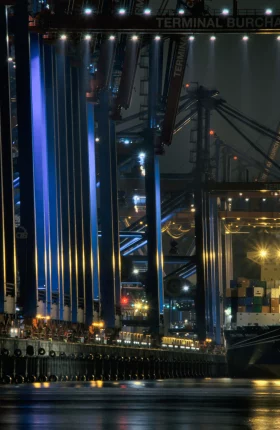Container seaports are essential nodes in the movement of goods around the world. Their ability to receive, organize, send forward, and transship cargo is critical to the smooth flow of global trade.
Yet the world’s container ports vary considerably in how efficiently they carry out their operations, which depends in large part on the degree to which they bring digital technologies to bear on the effort.
To better understand the level of digital maturity among the world’s ports, BCG and the Terminal Industry Committee 4.0 (TIC4.0)—an international not-for-profit association of terminal operators and equipment and solution providers dedicated to the creation and promotion of digital standards for the cargo-handling industry—have joined forces to conduct an in-depth survey whose goal is to create a benchmark for owners and operators to assess their progress in port digitalization. The survey data consists of self-assessments by representatives of 32 terminals across four continents, including gateway and transshipment facilities of varying scales, operated by either independent or liner-owned operators.
The results clarify the degree to which port digitalization supports operations across a range of digital capabilities, from container tracking and berth planning to crane dispatching and external data exchange. Closer analysis of the results reveals the importance of port digitalization to a wide range of critical port functions—and the business value it can provide.
Stay ahead with BCG insights on transportation and logistics
Choppy Seas
The world’s ports have made tangible progress in recent years in their efforts to digitize, but their maturity levels vary widely across terminal types and operational processes. The availability of technology is not the sole driver of this variation. External factors such as organizational complexity, regulatory environments, financial capabilities, labor models, and port ecosystem fragmentation also play significant roles in shaping adoption trajectories.
Although every terminal we surveyed has been making progress, most development of digital roadmaps occurs at the individual terminal level, with no widely adopted public standards, even within companies that manage a large number of port assets. As a result, aligning digital efforts across terminals remains difficult. The benchmark aims to address that challenge by offering a shared understanding of where digitalization efforts are falling short and how ports can align their efforts more effectively.
Maturity varies across port archetypes. Not surprisingly, ports that have reached a critical size in terminal capacity or ecosystem dynamism are significantly more digitally mature. Large terminals—those with a capacity of more than 1.5 million 20-foot-equivalent container units (TEUs)—located in Europe, the Middle East, and Africa (EMEA) consistently lead in the digitalization of macro-processes, which we define as six focus areas that can take advantage of influential digital levers because of the business functions they influence. These macro-processes are yard operations, gate and landside flow, external stakeholder integration, horizontal transport, vessel and port call operations, and equipment automation. Large ports benefit from their greater ability to invest in digitalization.
In contrast, the type of port operator (liner company or independent) and the primary cargo type (gateway versus transshipment) have less impact on overall maturity levels. Gateways are slightly ahead of transshipment terminals in digital gate and landside flows as a result of using fully automated gate and scanning systems, rather than requiring manual verification, to serve their traffic flow and to coordinate with other stakeholders. Transshipment terminals, in contrast, lead in digital yard operations, such as using digitally driven real-time optimization, rather than rule-based systems, in container stacking. Ensuring efficient internal flow and quay productivity is core to their business model.
Liner-owned and independent operators show comparable maturity overall. However, liner-owned terminals perform better in horizontal transport, such as using automated tools instead of basic tools for route optimization, and in yard operations, including real-time terminal operating system updates on container loading and discharge through Internet of Things (IoT) sensors instead of relying on near-real-time updates using mobile devices. This is likely due to the tighter integration of their shipping networks and their greater exposure to volume fluctuations.
These findings suggest that, despite structural differences, ports are directing their efforts toward digital transformation in response to shared pressures and would benefit from more consistent, standardized approaches.
Charting the Course
Despite the variability in maturity of the world’s ports, our digital ports benchmark suggests a common investment pathway, although not a one-size-fits-all solution. The sequencing and focus of digital initiatives should ultimately reflect three major considerations: the specific value that the initiative will deliver to individual port clients, the competitive environment, and the expected financial return.
In many instances, however, terminals can benefit from starting with capabilities that are fully under their control and where the operational returns are immediate.
- Optimizing yard operations is typically the starting point. Today, rule-based systems widely support yard operations, but predictive optimization—such as dwell time forecasting and smart stacking—is emerging as the next key milestone.
- Improving gate and landside flows follows, especially for gateway ports, where digital tools such as vehicle booking systems, license plate recognition, and e-documentation are already delivering efficiency gains. Dynamic scheduling and efficient loading of trucks through full truck-cycle integration are emerging as next steps.
- Boosting external stakeholder integration is another potential early focus area. As critical nodes in global supply chains, ports play a unique role as integrators, and more mature digital communications would help enable seamless data exchange with port authorities, customs, shipping lines, cargo owners, and inland transportation. This critical capability is highly dependent on cooperation and standardization, and thus requires alignment on shared data definitions, processes, and interfaces. Priority milestones include integration between shipping lines and customs authorities of standardized data transfer protocols.
The next phase of the roadmap could focus, in order of priority, on three other key areas that remain less mature:
- Predictive berth planning and port call optimization offer considerable potential to improve vessel turnaround. But several factors hinder adoption of advanced digital processes for these capabilities—in particular, the need to collaborate with carriers and authorities, restricted access to real-time data, concerns related to cybersecurity, and a lack of internal analytical capabilities. As a result, most terminals still rely on basic digital tools, while only the largest gateways deploy more advanced solutions. To unlock broader adoption, advanced berth planning tools that permit the collection of critical data will be key enablers.
- Horizontal transport of containers is often paired with yard operations in highly automated terminals, but equipment capabilities constrain progress in this area. Although many terminals use digital scheduling and dispatching, real-time adaptive routing has not advanced very far. Introducing dynamic scheduling and routing based on real-time yard and equipment conditions would enhance internal flow and equipment utilization.
- Equipment automation, contrary to a common belief, is the most underdeveloped digital capability, although its level of maturity strongly corelates with geography. Ports are making some progress in this area, particularly in large gateway terminals in EMEA. The slower rate of adoption reflects barriers such as high capital costs, regulatory constraints, labor model rigidity, and social resistance, as well as challenges involving the integration of newer digital processes with legacy equipment. Future meaningful progress will depend on the deployment of remote operations, IoT-enabled visibility, and advanced navigation systems.
Safe Harbor
The correct route to reach digital transformation of the world’s ports is becoming clearer, but it must be customized, not standardized. Although the benchmark highlights common enablers and pain points, the optimal sequencing of digital initiatives will vary in keeping with each terminal’s operating context, customer priorities, and business case. For example, greenfield or highly automated terminals may prioritize horizontal transport earlier in the transformation process, while large gateway ports facing berth congestion may move port call optimization ahead of broader ecosystem integration. Implementing capabilities that remain less mature will require targeted pilots, interoperability standards, and scaled proof points to drive wider adoption.
To define the right priorities and unlock the full value of digital transformation, ports must move beyond isolated initiatives and align on common standards, shared data definitions, interoperable processes, and scalable solutions. This coordinated approach is the foundation for collective progress in a complex, interdependent port ecosystem.
The authors would like to acknowledge the contributions of Tanguy Le Quilliec, Nouha Idrissi Belkasmi, and Marion Muller to the development of this article.
For more information on the benchmark, please contact us at portsbenchmarking@bcg.com.
To enquire about TIC4.0, please visit http://www.tic40.org or contact president@tic40.org.
About the Terminal Industry Committee – TIC4.0
The Terminal Industry Committee 4.0 (TIC4.0) is an international non-profit association established in 2019 and based in Brussels, dedicated to defining digital-based standards for enabling faster and more efficient digital transformation of the cargo handling industry. Bringing together global terminal operators, equipment manufacturers, and technology providers, TIC4.0 defines harmonised terminology as well as a unified language, semantics and data models to facilitate interoperable, efficient, and scalable digital solutions across terminal operations and port logistics.
TIC4.0 currently gathers more than 70 companies of the worldwide terminal and port industry, connecting experts in operations, engineering, IT, data and AI scientists as well as port equipment specialists. At technical level, TIC4.0 is organised in task-forces, which define univocal vocabulary, terminology and data models of specific topics related to terminal automation, digital twins, yard optimization, KPIs and other relevant areas where the implementation of digital standards is crucial for increasing efficiency, competitiveness and sustainability of the industry.
TIC4.0 drives the adoption of Industry 4.0 principles by delivering technical publications, supporting proof-of-concept projects, and developing a Publicly Available Specification (PAS 4000) together with the British Standard Institution as a precursor to international standards. The association also collaborates closely with research institutions and EU-funded innovation projects to promote harmonized, future-ready terminal ecosystems.
For more information, visit www.tic40.org.






